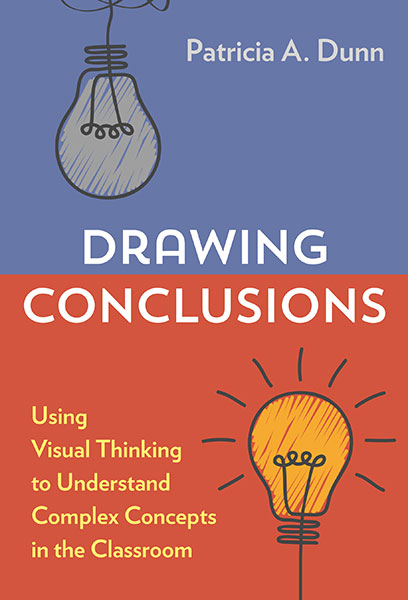Professors: Request an Exam Copy
Print copies available for US orders only. For orders outside the US, see our international distributors.
Publication Date: February 12, 2021
Pages: 128

Drawing Conclusions explores the use of juxtaposed visual representations (JVRs) to help preservice teachers grapple with abstract concepts, theories, or complex controversies in education. Acting as both a learning tool and an intellectual spark, JVRs are two simple contrasted sketches that students produce on a divided sheet of paper. In these drawings, students attempt to visually represent contrasting ideas that the class is struggling to understand (such as code-meshing versus code-switching, descriptive versus prescriptive grammar, peer response versus peer editing). JVRs are powerful tools for the teacher education classroom because they employ active learning and scaffold pedagogical strategies, act as a low-stakes but important formative assessment tool, help students grapple with complex literary and critical theories, and aid in reorganizing and revising a long writing project.
Book Features:
Patricia A. Dunn is a professor of English at Stony Brook University.
“This is a valuable resource and direction for those in all fields of education.”
—Teachers College Record
“In Drawing Conclusions by Patricia A. Dunn, we see an alternative approach that helps students pursue a more significant understanding of literacy concepts by creating visual representations of confusing or complex topics.”
—Teaching English in the Two-Year College
“The world is a symphony of words and images. Dunn masterfully illustrates how teachers and learners can more deeply define and discuss complex concepts and ideas through visual representations, and in turn become more critical creators and consumers of the world.”
—Shelbie Witte, Kim and Chuck Watson Endowed Chair, Oklahoma State University
“In the clearly written Drawing Conclusions, Patricia Dunn presents a well-balanced examination of the theoretical grounding and pedagogical application supporting the use of juxtaposed visual representations (JVRs) for students’ exploration of abstract concepts. The inclusion of numerous student artifacts from multiple classes to both explain and illustrate uses of, responses to, and misconceptions about JVRs is a clear strength of the book, highlighting Dr. Dunn’s thoughtful and thorough investigation of an activity that supports both critical and reflective thinking.”
—Melanie Shoffner, professor, James Madison University
Contents
Introduction 1
Why Student-Produced Juxtaposed Visual Representations? 2
Advantages of Juxtaposed Visual Representations 8
1. Preparing to Juxtapose Visual Representations 13
Modeling the Process 13
Deepening Discussions 19
2. Pathos, Perspective Shifts, and Metaphors 26
Pathos, Drama, and Stick Figures 27
Perspective Shifts 37
Metaphors 40
3. Sketches as Formative Assessment 52
Teaching Troublesome Knowledge 54
Assessing Conceptual Understanding 56
Promoting Deeper Learning 63
4. Grappling With Traditional Versus Contemporary/Critical Theory 74
Text-as-Shoe Metaphor 75
Readers’ Awareness of Lenses 76
Print Versus Audio Texts 78
Problematic Canonical Texts 81
5. Sketching as a Tool for Reorganization 88
Juxtaposing to Troubleshoot 88
Viewing Versus Discussing 93
Proposed Changes to the Process 100
6. Student Responses to Juxtaposed Visual Representations 102
Analyzing Survey Results 103
Students’ Comments 105
Conclusion 106
Appendix: Survey—Students’ Views on Using Juxtaposed Visual Representations 107
References 110
Index 114
About the Author 120
Download Survey / Questionnnaire in PDF
Professors: Request an Exam Copy
Print copies available for US orders only. For orders outside the US, see our international distributors.